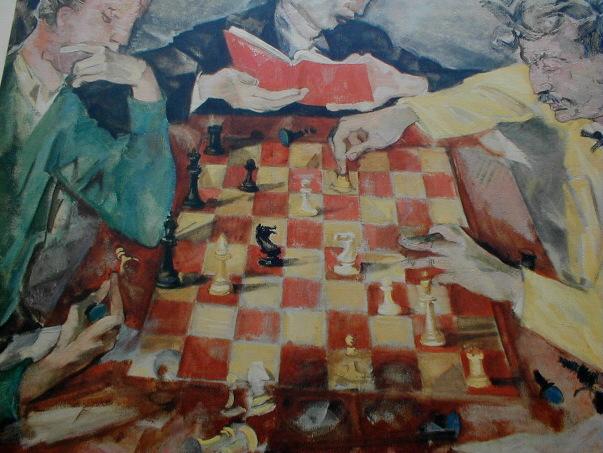Contents of CT-Art by Combinational Motif
For those who don't use CT-Art and are curious here is the listing of combinational motifs. When one enters the practice mode by Level. Problems occur in the order listed below. (the first 10 problems involve Knight forks)
Combinational motifs
1. GEOMETRICAL MOTIF
1.1. Knight forks
1.1.1. Removal of defence
1.1.2. Decoy
1.1.3. Square clearance
1.1.4. Conjunction of methods
1.2. Files (ranks)
1.3. Diagonals
1.3.1. Removal of obstacles
1.3.2. Opening of a diagonal
1.3.3. Decoy
1.3.4. Two diagonals
1.4. Pawn forks
1.5. Conjunction of geometrical motifs
2. WEAKNESS OF A FILE
2.1. The back rank
2.1.1. Annihilation of defence
2.1.2. Distraction
2.1.3. X-ray attack
2.1.4. Interception
2.1.5. Conjunction of methods
2.2. The seventh rank
2.3. The h-file
2.3.1. Mate to a "cramped" king
2.3.2. The g6-pawn
2.3.3. Attack on a fianchetto
2.3.4. Opening of a file
2.3.5. Decoy
2.4. The g-file
2.5. Central files
2.6. Diagonals
2.7. Conjunction of files, ranks and diagonals
3. OPPOSING
3.1. Open attack
3.1.1. Execution of an open attack
3.1.2. Opening of a file
3.1.3. Unblocking a pawn
3.1.4. Removal of defence
3.1.5. Decoy to the opposing file
3.1.6. Decoy to the blow dealt by the piece moved away
3.1.7. Placement of the attacking piece to the opposing file
3.1.8. "Mill"
3.2. Exploiting a pin
3.2.1. Attack on a pinned piece
3.2.2. Distraction of a pinned pawn
3.2.3. Other ways of exploiting a pin
3.3. Decoy for a pin
3.3.1. Attack on a pinned piece
3.3.2. Attack on a piece wich lost its defence
3.4. Counterblow by a "pinned" piece
3.5. Conjunction of methods
4. WEAKNESS OF A SQUARE(S)
4.1. "The hole" of the fianchettoed bishop
4.1.1. The h-file
4.1.2. The back rank
4.1.3. The pawns on f6,h6,a6 and c6
4.1.4. The others
4.2. Invasion of a file
4.3. Other cases
5. A PIECE IS OVERLOADED
5.1. A bishop is overloaded
5.2. A knight is overloaded
5.3. A rook is overloaded
5.4.A queen is overloaded
6. LACK OF DEFENCE OF THE PIECES
6.1. Annihilation of defence
6.2. Distraction
6.3. Decoy
6.4. Distraction with decoy
6.5. The others
7. BAD POSITION OF THE PIECES
8. PASSED PAWN
8.1. Pawn breakthrough
8.2. Distraction
8.3. Interception or blocking
8.4. A pawn is promoted to a knight
8.5. Forcing necessary exchanges
8.6. Both opponents have dangerous passed pawns
8.7. Passed pawn
Combinational motifs
1. GEOMETRICAL MOTIF
1.1. Knight forks
1.1.1. Removal of defence
1.1.2. Decoy
1.1.3. Square clearance
1.1.4. Conjunction of methods
1.2. Files (ranks)
1.3. Diagonals
1.3.1. Removal of obstacles
1.3.2. Opening of a diagonal
1.3.3. Decoy
1.3.4. Two diagonals
1.4. Pawn forks
1.5. Conjunction of geometrical motifs
2. WEAKNESS OF A FILE
2.1. The back rank
2.1.1. Annihilation of defence
2.1.2. Distraction
2.1.3. X-ray attack
2.1.4. Interception
2.1.5. Conjunction of methods
2.2. The seventh rank
2.3. The h-file
2.3.1. Mate to a "cramped" king
2.3.2. The g6-pawn
2.3.3. Attack on a fianchetto
2.3.4. Opening of a file
2.3.5. Decoy
2.4. The g-file
2.5. Central files
2.6. Diagonals
2.7. Conjunction of files, ranks and diagonals
3. OPPOSING
3.1. Open attack
3.1.1. Execution of an open attack
3.1.2. Opening of a file
3.1.3. Unblocking a pawn
3.1.4. Removal of defence
3.1.5. Decoy to the opposing file
3.1.6. Decoy to the blow dealt by the piece moved away
3.1.7. Placement of the attacking piece to the opposing file
3.1.8. "Mill"
3.2. Exploiting a pin
3.2.1. Attack on a pinned piece
3.2.2. Distraction of a pinned pawn
3.2.3. Other ways of exploiting a pin
3.3. Decoy for a pin
3.3.1. Attack on a pinned piece
3.3.2. Attack on a piece wich lost its defence
3.4. Counterblow by a "pinned" piece
3.5. Conjunction of methods
4. WEAKNESS OF A SQUARE(S)
4.1. "The hole" of the fianchettoed bishop
4.1.1. The h-file
4.1.2. The back rank
4.1.3. The pawns on f6,h6,a6 and c6
4.1.4. The others
4.2. Invasion of a file
4.3. Other cases
5. A PIECE IS OVERLOADED
5.1. A bishop is overloaded
5.2. A knight is overloaded
5.3. A rook is overloaded
5.4.A queen is overloaded
6. LACK OF DEFENCE OF THE PIECES
6.1. Annihilation of defence
6.2. Distraction
6.3. Decoy
6.4. Distraction with decoy
6.5. The others
7. BAD POSITION OF THE PIECES
8. PASSED PAWN
8.1. Pawn breakthrough
8.2. Distraction
8.3. Interception or blocking
8.4. A pawn is promoted to a knight
8.5. Forcing necessary exchanges
8.6. Both opponents have dangerous passed pawns
8.7. Passed pawn


0 Comments:
Post a Comment
<< Home